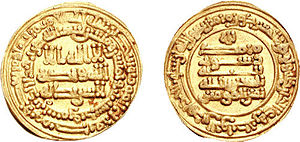
Back محمد المعتز بالله Arabic Mötəz (xəlifə) Azerbaijani معتز عباسی AZB আল-মুতাজ Bengali/Bangla Al-Mútazz (abbàssida) Catalan Al-Muʿtazz German Al-Mu'taz Esperanto Al-Mu'tazz Spanish معتز Persian Al-Mutazz French
| al-Mu'tazz المعتز | |||||
|---|---|---|---|---|---|
| Caliph Commander of the Faithful | |||||
 | |||||
| 13th Caliph of the Abbasid Caliphate | |||||
| Reign | 25 January 866 — 13 July 869 | ||||
| Predecessor | al-Musta'in | ||||
| Successor | al-Muhtadi | ||||
| Born | c. 847 Samarra, Abbasid Caliphate | ||||
| Died | July/August 869 (aged 22) Samarra, Abbasid Caliphate | ||||
| Burial | |||||
| Consort | Fatimah bint al-Fath ibn Khaqan (died 890)[1] Hassana al-Badawiyya[2] | ||||
| Issue | Abdallah ibn al-Mu'tazz | ||||
| |||||
| Dynasty | Abbasid | ||||
| Father | al-Mutawakkil | ||||
| Mother | Qabiha | ||||
| Religion | Sunni Islam | ||||
Abū ʿAbd Allāh Muḥammad ibn Jaʿfar (Arabic: أبو عبد الله محمد بن جعفر; 847 – 16 July 869), better known by his regnal title al-Muʿtazz bi-ʾllāh (المعتز بالله, "He who is strengthened by God") was the Abbasid caliph from 866 to 869, during a period of extreme internal instability within the Abbasid Caliphate, known as the "Anarchy at Samarra".
Originally named as the second in line of three heirs of his father al-Mutawakkil, al-Mu'tazz was forced to renounce his rights after the accession of his brother al-Muntasir, and was thrown in prison as a dangerous rival during the reign of his cousin al-Musta'in. He was released and raised to the caliphate in January 866, during the civil war between al-Musta'in and the Turkish military of Samarra. Al-Mu'tazz was determined to reassert the authority of the caliph over the Turkish army but had only limited success. Aided by the vizier Ahmad ibn Isra'il, he managed to remove and kill the leading Turkish generals, Wasif al-Turki and Bugha al-Saghir, but the decline of the Tahirids in Baghdad deprived him of their role as a counterweight to the Turks. Faced with the assertive Turkish commander Salih ibn Wasif, and unable to find money to satisfy the demands of his troops, he was deposed and died of ill-treatment a few days later, on 16 July 869.
His reign marks the apogee of the decline of the Caliphate's central authority, and the climax of centrifugal tendencies, expressed through the emergence of the autonomous dynasties of the Tulunids in Egypt and the Saffarids in the East, Alid uprisings in Hejaz and Tabaristan, and the first stirrings of the great Zanj Rebellion in lower Iraq.
- ^ Ibn al-Sāʿī (2017). Consorts of the Caliphs: Women and the Court of Baghdad. Translated by Shawkat M. Toorawa and the Editors of the Library of Arabic Literature. Introduction by Julia Bray, Foreword by Marina Warner. New York: New York University Press. ISBN 978-1-4798-0477-1.
- ^ Caswell, F.M. (2011). The Slave Girls of Baghdad: The Qiyan in the Early Abbasid Era. Bloomsbury Publishing. p. 278. ISBN 978-1-78672-959-0.
© MMXXIII Rich X Search. We shall prevail. All rights reserved. Rich X Search